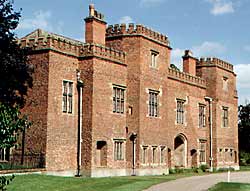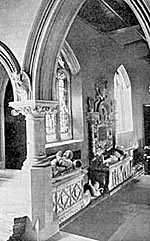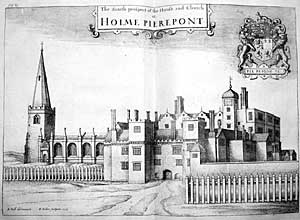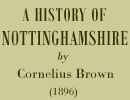< Previous | Contents | Next >
Holme Pierrepont

The brick south entrance range of Holme Pierrepont Hall was built in the early 16th century. (©A. Nicholson, 2000).
Another village on the banks of the Trent, near Nottingham, is Holme Pierrepont, which has been in the possession of scions of the House of Manvers as far back as the days of Henry I. When the sole heiress married Henry Pierrepont, temp. Edward I., she introduced to Holme an equally noble race (deriving their name from the castle of Pierrepont in France), with whose kindred the village has remained in constant association ever since. The first to give the Manor of Holme its distinctive appellation was this same Sir Henry Pierrepont, husband of Annora de Manvers. He participated in most of the great events of his day, and his eldest son was summoned among the Barons to advise with the King in the year 1304. Robert de Pierrepont, who succeeded his brother Simon, was Governor of Newark Castle in 1309. Many other members of the family bearing its honoured name took part in the famous battles of history.

Pierrepont monuments in the south aisle of Holme Pierrepont church.
In the little church, among the memorials which commemorate the illustrious dead, two, at least, are of considerable antiquity. One is the effigy of a knight, and probably represents Sir Henry Pierrepont, who fought against the Lancastrians in the wars of the Roses. Another Sir Henry, who had married a daughter of Sir William Cavendish, and his wife the famous ‘Bess of Hardwick,’ has a tablet erected to his memory over his tomb. This stalwart knight added considerably to the family mansion, and his grandson, the first Marquis of Dorchester, made further additions to it. Sir Henry was succeeded by his son Robert, who was raised to the peerage as Baron Pierrepont of Holme Pierrepont, Notts, and Viscount Newark, in 1627, and subsequently became Earl of Kingston-upon-Hull. Sir Bernard Burke says he was so popular with all classes for his benevolence and kindness of heart that he was usually styled ‘the good Earl of Kingston.’ When the Civil War broke out, the Earl of Kingston, according to Mrs. Hutchinson, for some time ‘stood neuter’; but he was soon after led to declare himself on the side of the Royalists, and was made Lieutenant-General of the Forces in the counties of Lincoln, Rutland, Huntingdon, Cambridge, and Norfolk. He met his death during the progress of the war, and the second Earl was created Marquis of Dorchester in 1643.
One of the most interesting monuments in Holme Church is on the pillar of an arch in the south aisle, and is to the memory of the poet Oldham, who was born in 1653, and was the son of a Nonconformist minister. He formed the friendship of Dryden, and attracted the attention of the Earl of Kingston, who invited him to Holme Pierrepont, where he died from small-pox when he was only thirty years of age. The mural tablet was erected by the Earl, and bears an elegant Latin inscription. His friend Dryden also bemoaned his fate in tributary verse, calling him the ‘Marcellus of our tongue.’
‘Thy brows with ivy and with laurels bound,
But fate and gloomy night encompassed thee around.’

Engraving in Thoroton's History of Nottinghamshire showing the hall and church as they appeared in the 1676.
Evelyn, the fifth Earl, was raised to the dignity of Knight of the Garter, and created, in 1715, Duke of Kingston-upon-Hull. His Grace was succeeded by his grandson, who leaving no issue, all his honours became extinct, but the estates passed to his nephew Charles, second son of Philip Meadows, Esq., by his wife, Lady Mary Frances Pierrepont, only sister of the Duke. This gentleman represented the county in Parliament, and was raised to the peerage in 1796 as Baron Pierrepont and Viscount Newark. He was advanced to the dignity of Earl Manvers in 1806, and on his death was buried at Holme Pierrepont, where there is a monument to his memory on the south wall of the chancel testifying to his unexampled worth.
In the chancel is also a beautiful monument by Flaxman in memory of the Rev. William Saltern, drowned while skating on the lake at Thoresby in 1811, and in the churchyard is a tomb to ‘Francis Dort de la Borde, of Mereville and Chessey, in the once flourishing kingdom of France,’ who was buried here in accordance with his own request in 1802.
